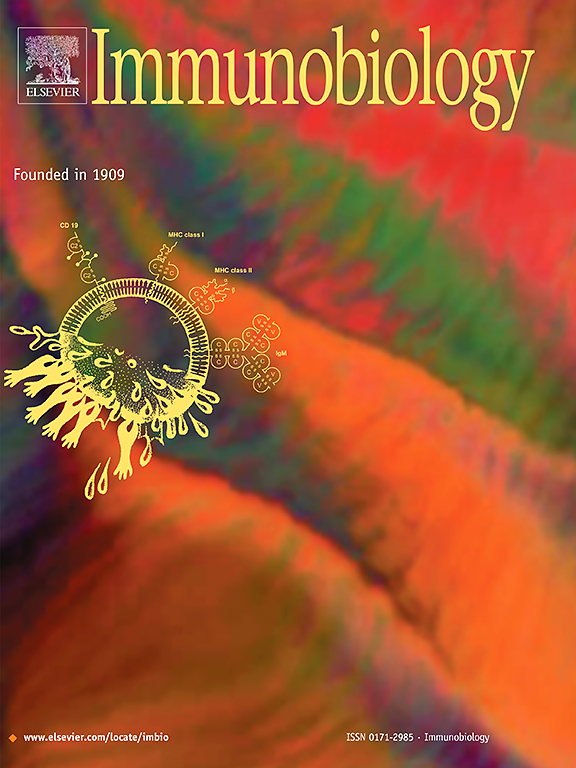长骨育金汤通过增强线粒体自噬和抑制NLRP3炎症小体介导的焦亡来减轻图雷特综合征
IF 2.3
4区 医学
Q3 IMMUNOLOGY
引用次数: 0
摘要
长朴育金汤是治疗抽动秽语综合征(TS)的有效中药复方。然而,其精确的分子机制仍有待充分阐明。方法105只SD大鼠随机分为对照组(n = 15)和TS组(n = 90)。TS组采用3,3′-亚氨基二丙腈腹腔注射诱导。造模成功后,将TS组进一步分为模型组、噻必利组、CPYJT组、雷帕霉素(RAPA)组、3-甲基腺嘌呤(3-MA)组、CPYJT +3-MA组6个亚组(每组n = 15),分别给予相应药物治疗4周。结果与对照组相比,模型组大鼠的刻板行为和运动行为增加,纹状体神经元细胞和线粒体超微结构受损,PINK1/ parkin介导的线粒体自噬减少,NLRP3炎症小体活化。CPYJT减少了TS大鼠的刻板和运动行为,减轻了神经元细胞损伤,并修复了线粒体病理。此外,CPYJT和RAPA均能增强PINK1/ parkinson介导的有丝分裂,消除ROS积累,抑制NLRP3炎性体活化。值得注意的是,CPYJT抵消了3-MA对PINK1/ parkin介导的有丝分裂的抑制作用,从而抑制NLRP3炎性体的激活和热凋亡。结论cpyjt通过增强PINK1/ parkin介导的线粒体自噬和减少ROS积累,抑制NLRP3炎性小体活化,减少焦亡,从而改善TS。本文章由计算机程序翻译,如有差异,请以英文原文为准。

Changpu Yujin Tang mitigates tourette syndrome by enhancing mitophagy and suppressing NLRP3 inflammasome-mediated pyroptosis
Background
Changpu Yujin Tang (CPYJT) is an effective Chinese herbal compound for treating Tourette syndrome (TS). However, its precise molecular mechanisms remain to be fully elucidated.
Methods
105 SD rats were randomly divided into the Control (n = 15) and the TS (n = 90) groups. The TS group was induced by intraperitoneal injection of 3,3′-iminodipropionitrile. After successful modeling, the TS group was further divided into 6 subgroups (n = 15 in each group): the Model group, the Tiapride group, the CPYJT group, the Rapamycin (RAPA) group, the 3-methyladenine (3-MA) group, and the CPYJT +3-MA group, and were treated with the corresponding drugs for 4 weeks.
Results
Compared with the Control group, rats in the Model group showed increased stereotyped and motor behaviors, damage to striatal neuronal cells and mitochondrial ultrastructure, decreased PINK1/Parkin-mediated mitophagy, and activation of NLRP3 inflammasome. CPYJT reduced stereotyped and motor behaviors, attenuated neuronal cell damage, and repaired mitochondrial pathology in the TS rats. Furthermore, both CPYJT and RAPA enhanced PINK1/Parkin-mediated mitophagy, eliminated ROS accumulation, and inhibited NLRP3 inflammasome activation. Notably, CPYJT counteracted 3-MA's inhibitory effect on PINK1/Parkin-mediated mitophagy, thereby suppressing NLRP3 inflammasome activation and pyroptosis.
Conclusion
CPYJT inhibits NLRP3 inflammasome activation and reduces pyroptosis by enhancing PINK1/Parkin-mediated mitophagy and attenuating ROS accumulation, which in turn ameliorates TS.
求助全文
通过发布文献求助,成功后即可免费获取论文全文。
去求助
来源期刊

Immunobiology
医学-免疫学
CiteScore
5.00
自引率
3.60%
发文量
108
审稿时长
55 days
期刊介绍:
Immunobiology is a peer-reviewed journal that publishes highly innovative research approaches for a wide range of immunological subjects, including
• Innate Immunity,
• Adaptive Immunity,
• Complement Biology,
• Macrophage and Dendritic Cell Biology,
• Parasite Immunology,
• Tumour Immunology,
• Clinical Immunology,
• Immunogenetics,
• Immunotherapy and
• Immunopathology of infectious, allergic and autoimmune disease.
 求助内容:
求助内容: 应助结果提醒方式:
应助结果提醒方式:


